An Insider’s Tour of Sicily With Evan Funke Includes Arancini the Size of Your Face and the Best Granita on the Planet
A research trip to the island with the Los Angeles chef is a deep dive into Sicilian foodways.
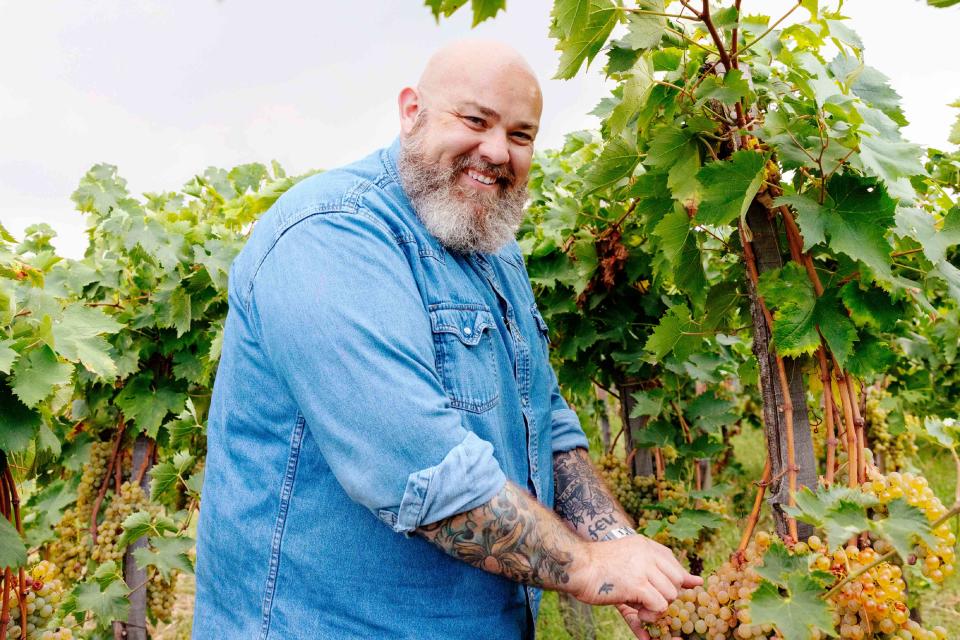
Cedric Angeles
Chef Evan Funke in the vineyards of I Vigneri di Salvo Foti, near Mount Etna"It's time to smuggle some s---,” chef Evan Funke jokes as we climb into the Land Rover Defender, arguably the largest vehicle the majority of Italy’s streets have ever seen. Funke, the chef behind Los Angeles pasta temples Felix Trattoria and Mother Wolf and the recently opened Funke, is not talking about drugs or antiquities. He is speaking of seeds — more specifically about seeds from bergamot, the bright and fragrant citrus fruit that punctuates the landscape of Calabria, the final stop on our road trip down the boot of Italy before we journey to the island of Sicily. There, Funke hopes to further his collection of seeds for plants like cedro, a lemon with a thick, white edible pith with the flavor and texture of a perfectly tart Granny Smith apple.
In the past, Funke occasionally lifted seeds from Italy and brought them back to the U.S., at times giving them to multiple farms across Southern California, to see which plants might thrive in the local terrain. The effort was worth it for Funke, who remains determined to preserve Italian foodways as close to their original form as he can, from the rhythm of the hands that taught him to make a pasta shape to the ingredients themselves, even though he is thousands of miles and an ocean away from Italy.
Funke makes no actions, small or large, without a certain level of determination or clarity — this trip included. He likes to dive deep, immersing himself in one place. Sometimes, he lets himself get lost and wander, relying on conversations with locals to help him build out his culinary journey. Other times, he does what he calls “full saturation.” When researching pizza-making in Naples, Funke says he ate three pizzas a day for 30 days. To better understand cacio e pepe before opening Felix in 2017, he ate 32 versions of the dish in 23 days across Rome and greater Lazio. This trip is not like his usual ones, though. It’s not just a research trip for his upcoming eponymous restaurant, which is his most ambitious and personal project yet. For Funke, it’s part of a larger pilgrimage to reset his culinary North Star.
Related: Why You Should Be Drinking More Wine from Sicily and Puglia
To do so, he has put himself in the hands of Davide Baroncini, the charming, chain-smoking owner of Ghiaia Cashmere, a high-end Italian menswear line — and one of the few people in Los Angeles as dedicated to their own craft as Funke is to his. Baroncini is the type of person who always knows a guy who knows a guy who can get you whatever you need. He’s someone whose corporeal form can barely contain the passion he exudes for life ... and most importantly for his native Sicily. His tour isn’t one you can find in the guide books, travel magazines, or Netflix shows. In many ways, it still is very much a “full-saturation” approach, with Baroncini’s gut guiding Funke through his misunderstood homeland. (“Americans see a caricature version of Italy,” Baroncini tells me.) Also along for the adventure is Baroncini’s wife, Pia, an influencer and the designer behind the fashion brand LPA. Davide and Pia set an ambitious agenda, bursting with meals and 5 a.m. wake-up calls to fit it all in.
We drive the Defender onto the ferry in Reggio Calabria to make the 40-minute journey across the Strait of Messina to Sicily. First up, Baroncini’s home city of Catania. It’s an hourlong drive south (or, in the hands of Davide Baroncini, a quick 40-minute sprint) from the ferry crossing in Messina to the city, located on the island’s eastern coast. There’s an endearing grittiness to Catania. The streets are perhaps less polished than cities in Italy’s north, but a generous sense of hospitality seems to course through it, and in fact the island as a whole. We head straight to Caffè Europa — a delightfully old-school restaurant with a massive curved glass pastry case and servers dressed in three-piece suits. Baroncini says the café is like the “town center in Catania, where people from all walks of life gather.” Just a few minutes later, as if on cue, he runs into an old childhood friend.
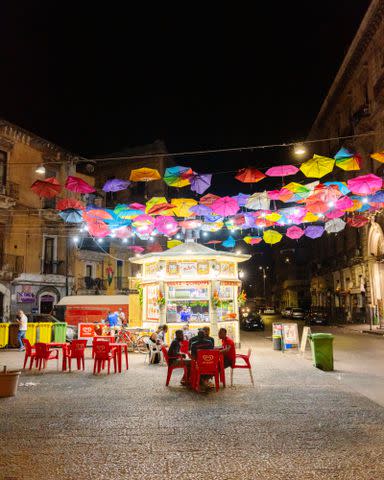
Cedric Angeles
Customers enjoy a limone seltzer under umbrellas in a piazza in CataniaIt’s breakfast time, which means one thing at Caffè Europa: time to order granita. The granita in Sicily, though, is not the stiff, icy dessert you might find elsewhere. It has an almost churned texture to it, the love child of a sorbet and a Slurpee. There’s an assortment of flavors ranging from fruity to chocolate, but the ideal combination is coffee and mandorla, or almond granita. And since breakfast is the meal of champions, the granita must be ordered “con panna e brioche,” or, with a generous cloud of lightly sweetened and freshly whipped cream and a round of supremely tender, but not overly buttery, brioche for dunking. Funke, dressed in his daily uniform of denim pants, a well-fitted chambray shirt, and classic brown Birkenstock Boston clogs, tears a chunk off the brioche before cupping both hands around the bread and bringing it to his nose for a deep inhale. It’s how he catalogs scents for his own mental archives, drawing on and analyzing the scent memories to reproduce everything as closely as he can when he gets back to Los Angeles.
Breakfast is immediately followed by lunch at Oasi Frutti di Mare da Nitto, one of Catania’s beloved seafood restaurants. Plates of pasta tossed with fresh sea urchin arrive at the table, along with the tiniest species of clam, native to the warm waters off the eastern shore of Sicily. Baroncini immediately makes friends with Nitto, the enthusiastic proprietor, who lets Funke sneak into the kitchen and watch his team at work. This setup is a common occurrence on this trip: Baroncini befriends the owner; Funke hops into a kitchen to observe and ask questions.
Lunch is followed by colossal arancini from Pasticceria Savia, a patisserie that has been around since 1897. We are joined by Nino Asaro, who splits his time between the U.S. and Sicily, where his family runs one of the region’s most lauded and substantial olive oil farms. Pasticceria Savia’s deep-fried rice fritters are shaped almost like giant teardrops and are stuffed with three fillings: a tender ragù oddly reminiscent of the inside of a burrito from Taco Bell, gooey cheese, or a pat of good butter. They are served piping hot from the fryer and only cost a couple of euros each — a meal that nearly anyone can afford. With each bite, you can see Funke’s brain tinker with what he’s eating, almost like a computer running a new algorithm. He is questioning how he has served arancini in the past: “Maybe you only really need one, and they should only be eaten standing?”
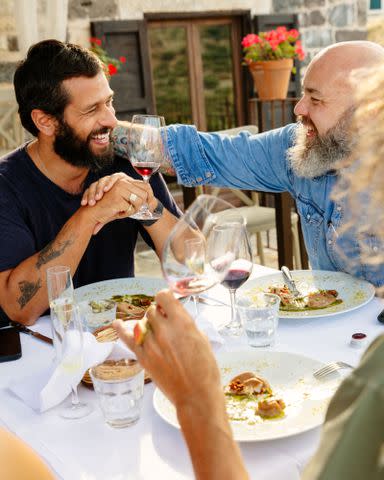
Cedric Angeles
Davide Baroncini (left) and Evan Funke. Baroncini, the owner of a luxury fashion brand, created the itinerary for Funkeâs Sicily visitBaroncini then guides our crew to a stretch of Via Plebiscito, where the meat markets were once located. We are here to eat a Sicilian delicacy: horse meat. The restaurant, La Terrazza Del Barone, is now run by Giovanni Barone, the second-generation owner. Still a young man, he has a wife, three kids, and a deep sense of purpose. “He just wants to preserve the Catanian way of life,” translates Baroncini. “He feels it is his duty.” Both Funke and Baroncini are moved to tears hearing Barone’s motivation, his commitment, and his hopes and dreams for the future. And soon, we are all seated at the giant outdoor tables as a parade of antipasti arrive before a pile of well-charred horse burgers (“Reminds me of the backyard burgers my mom used to make us after school,” says Funke), horse ribs, and the main star of the show, a horse steak, presented tableside by the chef, with Salt Bae–level theatrics.
The following day is spent driving up Mount Etna, the still-active volcano that is one of the defining geographic characteristics of the island. The terrain is almost Mars-like, consisting of giant dark rock formations formed from hardened lava. We stop into Macelleria Fratelli Cerra, a butcher shop in the quaint mountain town of Piedimonte Etneo. The incredibly friendly staff all wear shirts that read “passion for meat,” where hearts replace the letter “o.” And they immediately set to work handing out samples of everything in their case, from tender marinated mushrooms to salumi to ricotta so fresh that it will make you question if you’ve ever had real ricotta before. It’s not always possible to find domestic equivalents of these products in the U.S., and Funke is woeful that USDA importing regulations make it impossible for him to bring back a suitcase filled with certain meats and cheeses (which, unlike tiny seeds, cannot be tucked away inconspicuously).
We wind down the mountain with our snacks to I Vigneri di Salvo Foti, for glasses of wine. On a clear day, you can see Mount Etna looming to your right and the crystal blue waters of the ocean to your left while standing in the middle of the vineyards. Funke, determined to understand the flora of the island, plucks fruit from grapevines and pear trees and places a handful of fresh rosemary in his shirt pocket.
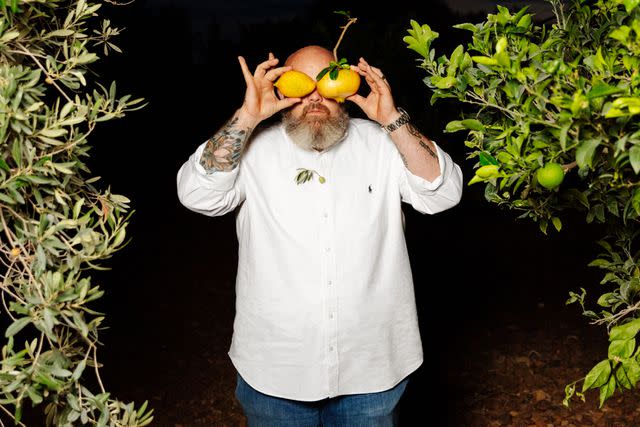
Cedric Angeles
Funke gets an eyeful of Sicilian citrusThere’s more granita the next day in the ancient and beautiful town of Noto. We hit the 131-year-old Caffè Sicilia for its incredibly fresh, fruit-forward granitas (though we all agreed the brioche was not as memorable as Caffè Europa’s) and a panna cotta with the perfect amount of jiggle and pure dairy flavor to stop Funke in his tracks. It’s fuel for the road trip to Cassaro, where Massimo Izzo, a jewelry designer and one of Baroncini’s best friends, has arranged an agricultural walk of Pantalica, a necropolis and now a nature preserve overgrown and bursting with local edible plants — if you know where to look. Our guide, Paolino Uccello, decked out in cargo pants and a pocketed vest, points out a thinner and milder version of asparagus than the one you might find in the U.S., then clips a bunch of oregano and mentuccia, an Italian mint variety, before stopping in front of a tuft of green that could easily be mistaken for a weed. He calls it ricottella and explains that when you chew on it, it tastes like ricotta. (The walk provides a bounty of inspiration for Funke’s seed-smuggling habit.) Funke does his signature inhale of each plant, adding new entries to his ever-expanding catalog of Italian foodways.
A late lunch after the walk is a multicourse meal centered around saffron; saffron crocuses grow abundantly in Sicily, but harvesting the spice is so labor-intensive that few care to do it. Our meal takes place at a masseria, or farmhouse, in the Sicilian countryside, an hour outside of Ortigia, the stunning island that forms the center of the city of Siracusa. We catch a few hours of sleep before cutting across Sicily and driving four hours to the tiny town of Partanna, the home of the Asaro family farm. Nino Asaro’s family makes the only olive oil Funke has cooked with for the past decade. (The Asaros also produce olive oil for Davide and Pia, who sell it under their Baroncini Import Co. brand; Funke has plans to partner with them on several products.) Nino guides the way to the family’s home near the olive oil factory, where his grandmother Nonna Lidia has expertly prepared crisp rounds of fried eggplant and a meaty sugo that she started making two days beforehand. Nino sets about transforming the sugo into lunch with dried busiate pasta the family also makes, while Funke, inspired by the morning’s agricultural walk, whips up a pan of fresh, rustic cavatelli that he tosses with generous amounts of Partanna olive oil, garlic, and mentuccia.
Related: This Cruise Around Italy Offers Guests Hands-On Experience Making Some of the Country's Best Dishes
Funke describes himself as a “godson” of Italian cooking. He sees himself as a vessel of knowledge first, a teacher second, and a chef last. Funke hopes to one day open an institute where he can pass on and preserve the techniques, recipes, and skills he has acquired so that no pasta shape or sauce or ingredient ever gets lost to history. But for now, he is spending his days acquiring knowledge directly from the true carriers of Italian culinary tradition: home cooks. “I could probably just learn some of these techniques online,” explains Funke. “But you miss out on the connection, on their stories, which are just as important as the techniques themselves.” He prides himself on the fact that he has learned 156 pasta shapes directly from various matriarchs he has encountered across his travels in Italy — and he won’t put a shape on the menus of his restaurants in Los Angeles until he has received approval and confirmation from the cook who taught him the shape that he has mastered it. “In the moment, I am like a kid to them,” says Funke. “They don’t always have people to pass this knowledge down to.” And though he is an extremely confident pasta maker — not much makes Funke nervous — he only starts to relax once his cavatelli gets a nod from Nonna Lidia.
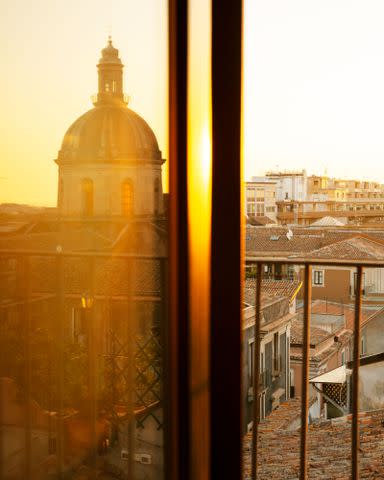
Cedric Angeles
Sunrise over the Church of Saint Michael Archangel in CataniaThat evening, Nino leads the group an hour up a winding, nail-biting set of roads deep in the Trapani hills of western Sicily. At the end of this dark, harrowing drive sits Ardigna, a literal glowing beacon of Sicilian hospitality. Nearly everything the restaurant serves is made in-house and grown within a small radius of the building. It’s run by Salvatore Adragna, who has the energy of a kid who just ate their entire Halloween candy stash. Adragna’s wife runs the kitchen, turning out what perhaps is the most robust spread of antipasti ever served: eggplant Parm, grilled snails in an earthy tomato sauce, housemade cheese, a massive hunk of fresh honeycomb, squares of farinata, bowls of marinated olives, cubes of focaccia — to name just a few. That’s followed by six kinds of pasta, several platters of meat, and a few rounds of dessert, including a lovely fruit platter stacked with local plums and prickly pears and a baked ricotta cake that has the entire table in silence.
It’s nearly 1 a.m. when we finally do the precipitous drive back down the mountain, only to wake up a few hours later, still full, to drive into Palermo, the last stop on the trip. We’re here for one place in particular: Panificio Graziano, legendary for its baked pastas and, more notably, its sfincione, a Sicilian dish best described as an airy pizza. In some ways, this is a full-circle moment: Funke is known for this sfincione in Los Angeles, but Graziano’s is in a wildly different style, a reminder of just how varied Italian cuisine really is. As we pass the pizza slices back and forth, I am truly not sure I will possibly eat another carbohydrate ever again. Funke gently laughs before restating something he told me earlier on the trip: “I’ll never get sick of pasta or pizza — ever.”
Related: Where to Eat Pizza in Los Angeles Right Now
In many ways, Funke is an unexpected ambassador and devotee of Italian cuisine. For one, he is not Italian. He isn’t fluent in the language, either. (Funke cheekily says he knows just enough Italian to “get himself into trouble.”) He understands that people might think he doesn’t have a right to cook and catalog Italy’s foodways because of his lack of Italian heritage, and to those doubts he responds that he would genuinely love to see the day when there are people even more infatuated with studying Italian culinary stories and techniques than he is. “I wish someone would challenge me,” he says.
Until that day, you will find him in the temperature-controlled pasta room at Funke, rolling and shaping dough with the knowledge of dozens of nonnas running through his fingers. Or in the kitchen, tinkering with his new arancini recipe. He excitedly hands me one, fresh from the fryer, when I walk into the restaurant after our trip: It’s a miniature version of the giant palm-sized one on the final menu, served one per order, shaped just like the one we had at Pasticceria Savia. I break it open, and the cheese gently oozes from the middle; the familiar Taco Bell flavor of the ragù immediately hits my tongue. For a moment, I forget I am in Beverly Hills and not on the sidewalks of Catania. “I think I figured it out 97%,” Funke tells me with a wink and a sheepish grin. I say he’s figured out how to make it even better.
Cavatelli con Aglio, Olio, e Mentuccia
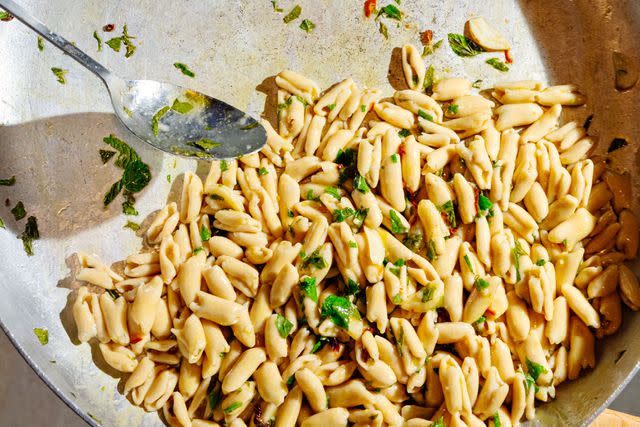
Cedric Angeles
Fresh, from-scratch cavatelli shine in a simple sauce of mint, olive oil, garlic, and chiles.
Arancini al Ragù (Risotto Croquettes with Beef Ragù)
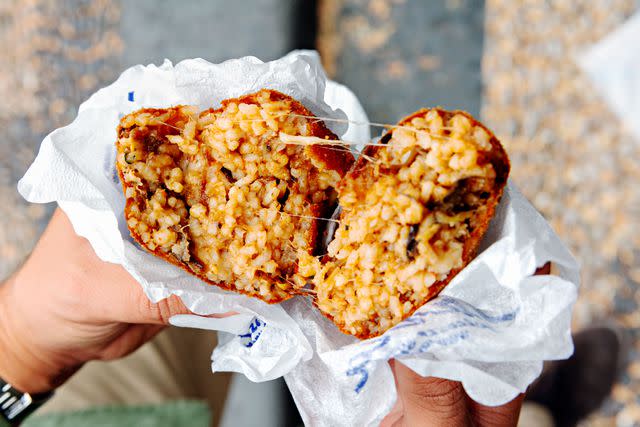
Cedric Angeles
These extra-large arancini contain a rich filling of meat sauce.
Spaghetti ai Ricci di Mare (Sea Urchin Spaghetti)
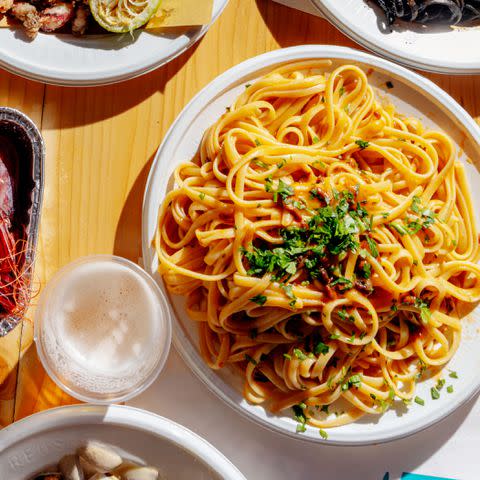
Cedric Angeles
If you’re lucky enough to have fresh sea urchin on hand and are wondering, “what now?”, this classic sea urchin spaghetti is your answer.
Granita di Mandorla con Panna Sotto e Sopra (Almond Granita with Whipped Cream “Top and Bottom”)
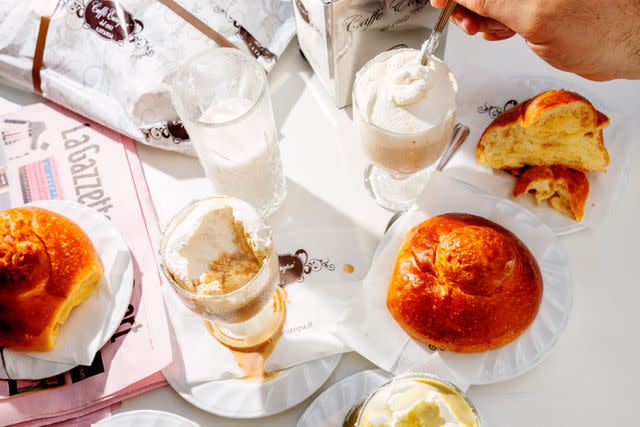
Cedric Angeles
This brilliant almond granita can be enjoyed for dessert or for breakfast.
For more Food & Wine news, make sure to sign up for our newsletter!
Read the original article on Food & Wine.

